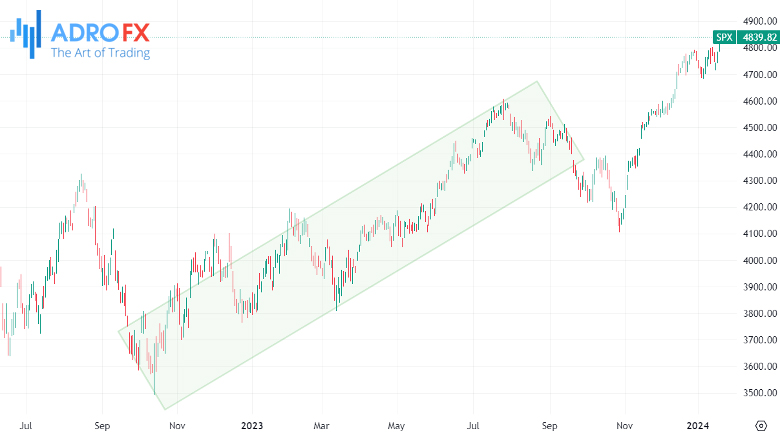Profiting in Bull Markets: Best Strategies for Success

In the financial markets, a bull market stands out as the most favorable period for both traders and investors. It signifies a time when various financial assets experience a robust uptrend, marked by the formation of "higher highs" (representing peaks in the price chart) and "higher lows" (indicating troughs in the price chart).
Throughout history, the financial market has witnessed several bull markets. A recent notable occurrence transpired following the onset of the COVID-19 pandemic in 2020. Despite an initial downturn in stocks and cryptocurrencies, they made a remarkable recovery, reaching record highs in 2021.
Another significant bull market unfolded after the Global Financial Crisis (GFC) in 2009. Despite a severe crash during the crisis, a strong bull market endured until 2020.
Conversely, a bear market represents the most challenging phase, resulting in substantial losses for long-term investors. An example of a bear market unfolded in 2022 when global central banks raised interest rates. This article aims to elucidate profitable trading strategies during a bull market.
Our focus is on delineating the most effective bull market strategies. However, before delving into this discussion, it's essential to elucidate the characteristics and causes of this upward trend. If you are already familiar with these concepts, feel free to skip directly to the strategies section.
What Constitutes a Bull Market and How Does It Operate?
A bull market signifies a period when the stock market experiences a robust uptrend. Typically, this is defined as a phase during which a major stock index, such as the S&P 500 or Nasdaq 100, ascends by at least 20%.

Similarly, an individual stock, cryptocurrency, or commodity can be deemed to be in a bull market when it registers a 20% rise from its lowest point within a specific period. Refer to the chart below for a clear illustration of a bull market.
Characteristics of a Bull Market
Bull markets exhibit diversity, yet they commonly share certain characteristics or qualities. Some notable features of a bull market include:
- Steady Uptrend
A crucial characteristic is the steady uptrend observed in stocks. Higher highs and higher lows evidence this as investors consistently seize buying opportunities.
While fluctuations may occur, the prevailing trend is upward.
- Pullbacks are Common
Bull markets experience periodic pullbacks, defined as brief downtrends resulting from traders securing profits.
Although pullbacks are usually short-lived, they might extend for several weeks, necessitating thorough analysis to avoid entering erroneous trades.
- Investor Confidence
Bull markets are marked by heightened consumer confidence. There is a prevailing sense of optimism that the stock market will continue flourishing.
Institutional and retail investors often gravitate toward winning assets.
- Lower Volatility
Bull markets tend to display lower volatility due to limited market swings. Notably, the VIX index plummeted to multi-year lows in 2023 as American equities surged.

- Higher Liquidity
High liquidity is a distinctive trait of a bull market as substantial funds from large investors and retail traders are allocated to stocks.
This behavior is rooted in human psychology, where people tend to invest in ascending assets. Brokerage firms like Robinhood and Interactive Brokers thrive in such conditions.
Additional characteristics of a bull market encompass steady economic growth, a generally dovish Federal Reserve, robust consumer confidence, and increased risk tolerance among investors.
Causes of a Bull Market
A frequently posed question revolves around the factors contributing to a bull market. Although each bull market is unique, several common causes are worth highlighting:
- Federal Reserve Decisions
The predominant driver of a bull market in the United States is the Federal Reserve. Bull markets typically occur in two scenarios.
Firstly, they transpire when the Fed is cutting interest rates. Instances include the periods following the Global Financial Crisis (GFC) and the COVID-19 pandemic, where equities and cryptocurrencies surged amid rate cuts.
Secondly, a bull market may materialize in anticipation of future rate cuts by the Federal Reserve. Notably, in 2023, stocks surged as inflation declined, hinting at potential rate cuts.
- Economic Boom
A bull market can emerge during an economic boom, characterized by a low unemployment rate, rising wages, and low inflation. During such periods, individuals tend to shift their holdings toward the stock market.
However, it's essential to note that a robust economy can sometimes impede a bull market, as it signals potential rate hikes by the Fed to prevent a harsh economic downturn.
- Corporate Earnings
Sustained periods of robust earnings growth within corporations are a significant cause of a bull market. This growth fosters optimism among traders, leading to increased inflows into the stock market.
Investors typically allocate more capital to companies exhibiting strong earnings growth.
- Black Swan Event
Another catalyst for a bull market often stems from a black swan event, considered a once-in-a-generation occurrence.
Despite initial stock market crashes in response to such events, a sharp rebound usually follows. This trend was evident during the COVID-19 pandemic, the dot-com bubble, and the Global Financial Crisis.
While exploring the causes of bull markets, it's crucial to emphasize that these favorable periods are rarely influenced by a single factor in isolation. Instead, bull markets are typically the result of multiple factors working in tandem. Whether it's Federal Reserve decisions, economic booms, corporate earnings, or unforeseen black swan events, the interplay of these elements contributes to the development and sustainability of a bull market.

Best Bull Market Strategies
Having examined the causes that drive bull markets, let's seamlessly transition into exploring effective strategies for trading during these periods. Understanding the dynamic forces behind bull markets lays the groundwork for implementing practical approaches to capitalize on favorable market conditions. Now, let's delve into the strategies that traders can employ to navigate and thrive in the upward trends characteristic of bull markets.
Trend Following
Trend following involves entering an existing bull trade where a trader buys into a market with a consistent upward trend. Key tools for managing dramatic pullbacks include moving averages, Bollinger Bands, and trendlines.
Strategy Implementation:
- Monitor stocks showing a consistent upward trajectory.
- Utilize indicators like moving averages and Bollinger Bands to identify potential entry points.
- Employ trendlines, connecting the lowest or highest market swings, and buy assets when above the trendline.
Buying the Dip
Buying the dip strategy entails waiting for a pullback to occur within a bull market and then making a purchase with the expectation of the asset resuming its upward trend.
Strategy Implementation:
- Use trend indicators, trendlines, and additional tools like Andrews pitchfork and Fibonacci Retracement.
- Purchase assets when they hit indicators during a dip and wait for the bullish trend to resume.
Channel Trading Strategy
The channel trading strategy involves drawing parallel lines connecting essential low and high swings, aiming to buy when the asset retests the lower side and short when it retests the upper side.
Strategy Implementation:
- Draw parallel lines connecting significant low and high swings.
- Buy when the asset retests the lower side and short when it retests the upper side of the channel.
- Acknowledge risks, such as continued upward movement after hitting the upper side or continued decline below the lower side.
News Trading
News trading relies on the release of breaking or scheduled news to enter a position, leveraging unexpected events or anticipated news like corporate earnings reports.
Strategy Implementation:
- Distinguish between breaking news (e.g., analyst upgrades/downgrades, CEO changes, activist investor entries) and scheduled news (e.g., corporate earnings).
- Adapt strategies based on whether to follow or fade the trend induced by news events.
Scalping
Scalping is a strategy where traders aim to make small profits by capitalizing on minor upward trends and executing multiple trades daily.
Strategy Implementation:
- Set a goal of making small profits per trade, multiple times a day.
- Use technical indicators like VWAP or moving averages for timely entries and exits.
Momentum
Momentum strategy involves buying and holding financial assets exhibiting momentum, utilizing trend indicators and momentum indicators like MACD, RSI, Stochastic Oscillator, and Rate of Change.
Strategy Implementation:
- Rely on trend indicators like moving averages and Ichimoku cloud, along with momentum indicators, to identify assets with sustained momentum.
Chart and Candlestick Patterns
Traders use chart and candlestick patterns to interpret market trends, distinguishing between continuation patterns signaling ongoing trends and reversal patterns indicating potential trend shifts.
Strategy Implementation:
- Identify popular candlestick patterns (e.g., evening and morning star, bullish and bearish engulfing, hammer, hanging man) and chart patterns (e.g., triangles, head and shoulders, wedges, cup and handle).
- Understanding and implementing these strategies equips traders to navigate and capitalize on the dynamic nature of bull markets effectively.
Final Thoughts
In the ever-evolving landscape of financial markets, navigating a bull market requires a nuanced understanding of its characteristics, causes, and effective trading strategies. As we've explored, a bull market embodies more than just a period of rising asset prices; it reflects a complex interplay of economic factors, investor sentiment, and institutional dynamics.
Understanding the technicalities, such as "higher highs" and "higher lows," serves as a foundational element for traders and investors aiming to capitalize on the opportunities presented by a robust uptrend. This knowledge acts as a compass, guiding market participants through the fluctuations and pullbacks inherent in bull markets.
Moreover, recognizing that multiple factors contribute to the onset and sustainability of bull markets is paramount. It's not merely the result of a singular event but often a confluence of influences, ranging from Federal Reserve decisions to economic booms and corporate earnings growth.
As we transition from comprehending the causes of bull markets, it's essential to seamlessly segue into actionable strategies. Successful trading during a bull market requires a strategic approach, be it through trend following, buying the dip, employing channel trading, leveraging news events, scalping, riding momentum, or identifying chart patterns.
In essence, navigating a bull market is an art as much as it is a science. It demands a continuous process of learning, adapting, and applying diverse strategies to align with the ever-changing dynamics of financial markets. The journey through a bull market is not without challenges, but for those equipped with knowledge, insight, and a well-defined strategy, it presents a canvas of opportunities to paint profitable outcomes.
In conclusion, as we embark on the exciting venture of navigating bull markets, let us remember that success lies not just in understanding the trends but in the adept application of strategies that turn market dynamics into avenues for financial growth. Happy trading!

About AdroFx
Established in 2018, AdroFx is known for its high technology and its ability to deliver high-quality brokerage services in more than 200 countries around the world. AdroFx makes every effort to keep its customers satisfied and to meet all the trading needs of any trader. With the five types of trading accounts, we have all it takes to fit any traders` needs and styles. The company provides access to 115+ trading instruments, including currencies, metals, stocks, and cryptocurrencies, which make it possible to make the most out of trading on the financial markets. Considering all the above, AdroFx is the perfect variant for anyone who doesn't settle for less than the best.









